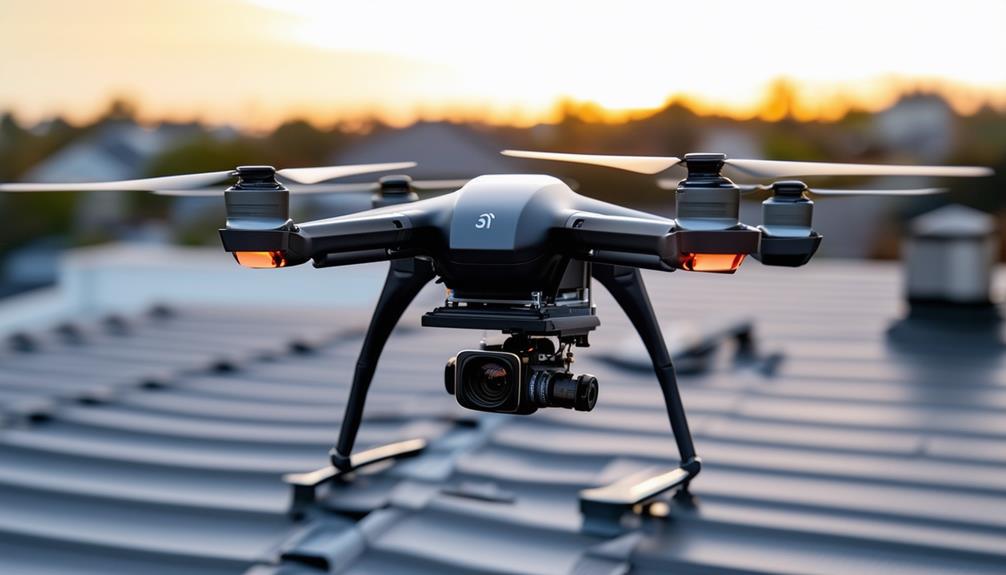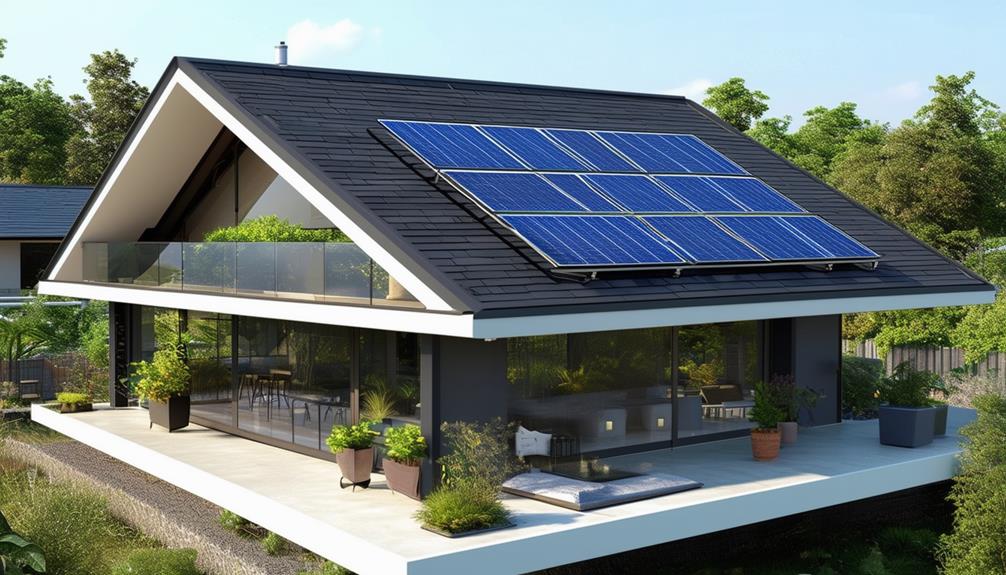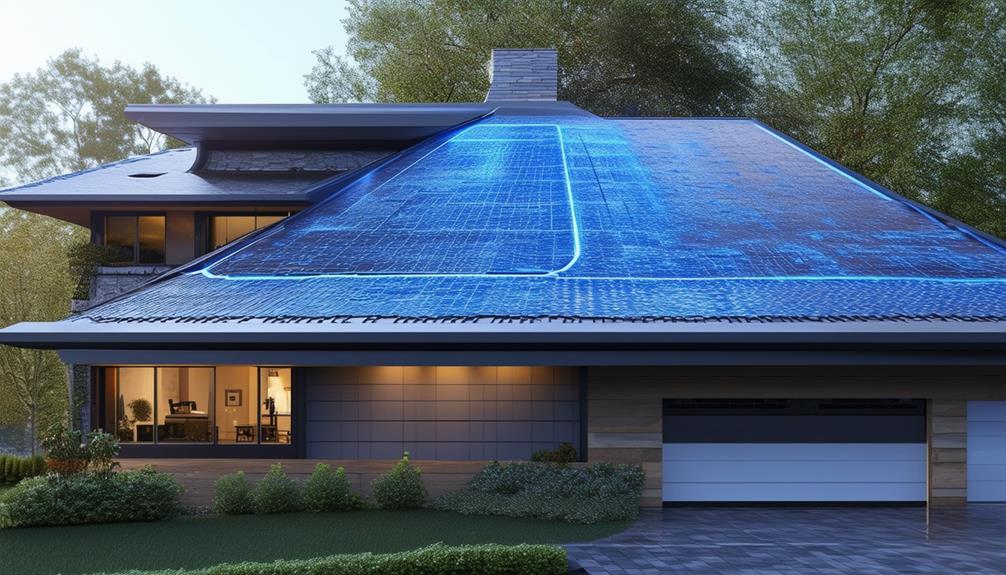Explore the latest roofing technologies shaping the industry today, like solar roofing for energy efficiency and green roofs promoting sustainability. Discover impact-resistant materials providing durability against harsh weather and cool roof coatings to lower cooling costs. Drone inspections revolutionize maintenance with detailed data analysis, while smart roofing systems monitor and alert proactively. Prefabricated components speed up installations, and sustainable practices reduce environmental impact. Enhanced durability options, 3D printing, and smart sensors improve efficiency and longevity. The advancements in roofing technologies offer a glimpse into the innovative future of the industry.
Solar Roofing Solutions

Discover the latest advancements in solar roofing solutions, revolutionizing the way energy is harnessed and utilized in the roofing industry. When considering solar roofing, it's important to evaluate the available financing options. Many homeowners opt for financing through solar loans, leases, or power purchase agreements to make the initial investment more manageable. These financing options often provide a cost-effective way to switch to solar energy without a significant upfront expense.
In terms of maintenance requirements, solar roofing systems are relatively low maintenance compared to traditional roofs. Regular inspections and cleanings are recommended to guarantee peak performance and longevity. Checking for debris accumulation, monitoring for any shading issues, and inspecting the integrity of the panels are essential maintenance tasks. Additionally, scheduling professional maintenance checks can help identify and address any potential issues promptly.
Green Roofing Innovations
One of the most notable advancements in the roofing industry is the introduction of innovative green roofing solutions that promote sustainability and environmental benefits. Eco-friendly solutions have become increasingly popular as individuals and businesses seek to implement sustainable practices. Green building technologies offer a range of environmental benefits, such as reducing energy consumption, improving air quality, and mitigating the urban heat island effect.
Installing green roofs, which are covered with vegetation, helps to regulate indoor temperatures, reduce stormwater runoff, and enhance biodiversity in urban areas. These roofs act as natural insulators, lowering heating and cooling costs while also extending the lifespan of the roof itself. Additionally, green roofs contribute to improving air quality by capturing pollutants and producing oxygen through photosynthesis.
Incorporating green roofing innovations into construction projects not only benefits the environment but also offers long-term cost savings and enhances the overall quality of life in urban environments. By embracing sustainable roofing practices, individuals and businesses can make a positive impact on the planet while enjoying the advantages of green building technologies.
Impact-Resistant Materials

When considering impact-resistant materials for your roofing needs, you'll find that the market offers enhanced durability options that provide increased longevity and protection for your roof. These advanced materials offer superior impact protection against harsh weather conditions, such as hail and wind, ensuring your roof remains intact and secure. By utilizing innovative material technologies, you can safeguard your property and minimize the risk of costly repairs due to impacts or severe weather events.
Enhanced Durability Options
Discover the latest advancements in roofing technologies with impact-resistant materials, designed to enhance durability and protect your property from potential damage. When it comes to enhancing the longevity of your roof, incorporating resilient materials with cutting-edge protection is key. By utilizing long-lasting coatings and implementing high-tech maintenance practices, you can greatly increase the durability of your roof.
Long-lasting coatings act as a shield against various environmental factors, such as UV rays, harsh weather conditions, and debris impact. These coatings not only provide an extra layer of defense but also contribute to the overall strength of the roof. Pairing them with high-tech maintenance techniques ensures that your roof remains in excellent condition for an extended period.
Investing in resilient materials that offer cutting-edge protection will not only safeguard your property but also save you from frequent repairs and replacements. By integrating these durability options into your roofing system, you can enjoy peace of mind knowing that your roof is well-equipped to withstand the test of time.
Advanced Impact Protection
Enhance the impact resistance of your roofing system by incorporating advanced materials designed to withstand external forces and protect your property effectively. Impact-resistant coatings and cutting-edge roofing technology play a vital role in safeguarding your roof against harsh weather conditions and potential damage.
Next-generation shingle designs are at the forefront of advanced impact protection. These innovative shingles are engineered with advanced materials that provide enhanced durability and resistance to impact. The incorporation of these advanced roofing materials guarantees that your roof can withstand the forces of nature, such as hail or falling debris, without compromising its integrity.
Innovative Material Technologies
To strengthen your roofing system against impact, explore the world of innovative material technologies that offer enhanced durability and resistance to external forces. Impact-resistant materials are essential for maintaining the integrity of your roof and protecting your property. One key technology that aids in this is the use of lightweight materials that provide strength without adding excessive weight to the structure. These materials, such as advanced composites or specially engineered metals, can withstand impact from hail, debris, or severe weather conditions.
Additionally, integrating a waterproof membrane into the roofing system enhances its resilience against impacts while preventing water infiltration. This membrane acts as a barrier, safeguarding the underlying structure from moisture damage and leaks. By combining impact-resistant materials with a waterproof membrane, you can significantly enhance the longevity and performance of your roof, ensuring it remains strong and secure for years to come.
When selecting roofing materials, prioritize those that offer both impact resistance and waterproofing capabilities to protect your investment and provide peace of mind in the face of unpredictable weather events.
Cool Roof Coatings
Cool roof coatings offer significant energy-saving properties by reflecting sunlight and reducing the amount of heat absorbed by the building. The reflective surface benefits not only help lower cooling costs but also extend the lifespan of the roof by reducing temperature fluctuations. Consider incorporating cool roof coatings to enhance energy efficiency and sustainability in your roofing projects.
Energy-Saving Properties
How do cool roof coatings contribute to energy efficiency in buildings? Cool roof coatings are an essential component of energy-efficient designs as they help reduce the heat absorbed by roofs, leading to lower indoor temperatures and decreased reliance on air conditioning. By reflecting sunlight and heat away from the building, these coatings play an important role in minimizing the urban heat island effect and enhancing overall energy efficiency.
Cost-effective solutions are a key aspect of cool roof coatings. By reducing the need for excessive air conditioning during hot weather, these coatings can greatly lower energy costs for building owners. The initial investment in applying cool roof coatings is often outweighed by the long-term savings achieved through reduced energy consumption. Additionally, cool roofing solutions can extend the lifespan of a roof by protecting it from thermal expansion and UV damage, further enhancing their cost-efficiency. These coatings are also an environmentally friendly choice, as they help reduce urban heat island effects and lower overall energy demand. By implementing cool roofing solutions, building owners can enjoy both financial savings and a positive environmental impact.
Reflective Surface Benefits
Cool roof coatings with reflective surfaces provide significant benefits in maintaining energy efficiency by reducing heat absorption and indoor temperatures in buildings. By reflecting sunlight away from the roof's surface, these coatings help lower cooling costs by reducing the need for air conditioning during hot weather. The energy efficiency of buildings is greatly enhanced as the reflective surfaces prevent heat transfer into the structure, keeping indoor spaces cooler and more comfortable.
Moreover, the longevity benefits of cool roof coatings are notable. By minimizing heat exposure, these coatings help extend the lifespan of the roof by reducing thermal expansion and contraction that can cause wear and tear over time. The reflective surfaces also protect the roof from UV radiation, preventing premature degradation of roofing materials. This not only saves on maintenance and replacement costs but also contributes to the overall sustainability of the building.
Drone Technology for Inspections

Utilizing drones for inspections in the roofing industry has revolutionized the way professionals assess and analyze the condition of roofs. Aerial inspections conducted by drones provide a thorough view of the roof, allowing for detailed data analysis without the need for manual labor or risky climbs. Through high-resolution cameras and thermal imaging capabilities, drones can detect issues such as water damage, leaks, or structural weaknesses that may not be visible to the naked eye.
Remote monitoring systems linked to drones enable real-time data collection and analysis. This data facilitates proactive maintenance solutions, as professionals can identify problems early on and address them promptly before they escalate into costly repairs. By incorporating drone technology into roofing inspections, companies can increase efficiency, accuracy, and safety in their maintenance practices.
Smart Roofing Systems
In the field of roofing technologies, the emergence of smart roofing systems marks a significant advancement in enhancing the efficiency and functionality of roof structures. By integrating smart sensors into roofing materials, these systems can monitor various parameters such as temperature, moisture levels, and structural integrity in real-time. Through the data collected by these sensors, smart roofing systems enable automated maintenance processes, allowing for thorough oversight of the roof's condition and performance and proactive identification of issues before they escalate.
Smart sensors embedded within the roof can detect leaks promptly, trace the source of the problem, and even trigger automated repair mechanisms. This level of automation not only enhances the longevity of the roof but also minimizes the need for manual inspections and maintenance checks. Additionally, smart roofing systems can be integrated with building management systems to provide detailed monitoring of the roof's condition and performance. As technology continues to advance, smart roofing systems are poised to revolutionize the way roofs are maintained and managed, ushering in a new era of efficiency and sustainability in the roofing industry.
Prefabricated Roofing Components

You can enhance efficiency and save time with modular roof systems that come as prefabricated roofing components. These systems offer rapid installation benefits, reducing labor costs and project timelines considerably. Embracing prefabricated components can streamline your roofing projects and provide a more cost-effective solution for your construction needs.
Modular Roof Systems
With the increasing demand for efficiency and speed in construction projects, modular roof systems have emerged as a cutting-edge solution in the roofing industry. These systems offer customizable aesthetics, allowing you to achieve the desired look for your building while benefiting from efficient installation processes.
Modular roof systems come with a range of design options that can be tailored to meet your specific requirements. Whether you prefer a traditional or modern appearance, these systems provide flexibility regarding colors, materials, and finishes. This customization aspect guarantees that your roof not only performs well but also enhances the overall visual appeal of your property.
In addition to their customizable aesthetics, modular roof systems are designed for efficient installation. The prefabricated components are manufactured off-site, reducing on-site labor and installation time. This streamlined process not only accelerates the construction schedule but also minimizes disruptions to your daily operations. By choosing a modular roof system, you can achieve a visually pleasing roof with a quick and hassle-free installation process.
Rapid Installation Benefits
Prefabricated roofing components offer a swift installation process that greatly reduces construction timelines and minimizes on-site labor requirements. The installation efficiency of prefabricated roofing components stems from their ability to be manufactured off-site, allowing for rapid deployment and assembly once they arrive at the construction site. This not only streamlines the installation process but also contributes to sustainable practices by minimizing material waste and reducing the overall carbon footprint associated with traditional roofing methods.
Sustainable Roofing Practices
Incorporating sustainable roofing practices is essential in reducing the environmental impact of construction projects and increasing the longevity of roofing systems. Eco-friendly installations and sustainable practices are becoming increasingly popular due to their long-term environmental benefits and green solutions. By utilizing materials such as recycled content, cool roofs that reduce energy consumption, and green roof systems that provide natural insulation and reduce stormwater runoff, you can greatly lower the carbon footprint of your building.
Furthermore, sustainable roofing practices not only benefit the environment but also offer financial advantages in the long run. Green roofs, for instance, can improve energy efficiency, reduce heating and cooling costs, and extend the lifespan of the roof membrane. Implementing sustainable practices in roofing not only aligns with eco-conscious trends but also demonstrates a commitment to responsible construction practices that can positively impact both the environment and your bottom line.
Advanced Weatherproofing Techniques

To enhance the durability and performance of roofing systems, implementing advanced weatherproofing techniques is essential in safeguarding structures against the elements. Waterproofing membranes play an important role in protecting roofs from water infiltration, preventing damage and leakage. Cutting-edge solutions in waterproofing technology involve the use of materials like synthetic rubber or thermoplastic membranes that provide superior resistance to water and weathering.
Climate-proof roofing requires innovative strategies to withstand the diverse conditions roofs are exposed to. Advanced weatherproofing techniques include the application of reflective coatings that help regulate rooftop temperatures, reducing energy consumption and enhancing overall efficiency. Additionally, the integration of self-healing materials in roofing systems can automatically repair minor damages caused by weather exposure, prolonging the lifespan of the roof.
3D Printing in Roof Construction
Advanced weatherproofing techniques in roofing systems have paved the way for the integration of 3D printing technology in roof construction, revolutionizing the way roofs are designed and built. 3D printing allows for the creation of highly customizable designs that can be tailored to meet specific architectural requirements. This technology enables architects and builders to bring intricate and unique roof designs to life with precision and efficiency.
One of the key advantages of using 3D printing in roof construction is the cost-effective solutions it offers. By using this innovative technology, materials can be optimized, reducing waste and overall construction costs. Additionally, the ability to create complex geometries with 3D printing can lead to more efficient use of materials, further contributing to cost savings.
Frequently Asked Questions
How Do Solar Roofs Perform in Extreme Weather Conditions?
Solar roofs effectively harness energy during sunny days, transferring excess power to the grid. They boast durability in extreme weather conditions like hail, wind, and snow. The materials used, such as tempered glass and sturdy metals, guarantee longevity and protection. These roofs are designed to withstand harsh elements, maintaining efficiency and structural integrity. When considering solar roofs, their performance in various weather conditions proves their reliability and resilience.
Are Green Roofs Suitable for All Building Types?
Green roofs, touted for their environmental benefits in urban environments, surprisingly may not suit all building types. Structural limitations and high maintenance costs can hinder their widespread adoption. While they offer sustainability advantages, it's crucial to evaluate the feasibility and long-term implications for your specific building. Before delving into green roofing trends, carefully assess the pros and cons to guarantee it aligns with your overall goals and budget constraints.
Can Impact-Resistant Materials Reduce Insurance Premiums?
Impact-resistant materials can indeed reduce insurance premiums. By enhancing the durability of your roof, these materials lower the risk of damage from hail, wind, or falling debris. This decreased risk can lead to potential cost savings on insurance premiums. Additionally, impact-resistant materials can contribute to energy efficiency by providing better insulation and reducing the need for frequent repairs, ultimately benefiting your overall roofing system.
What Is the Lifespan of Cool Roof Coatings?
Cool roof coatings have a lifespan ranging from 10 to 20 years, depending on factors like climate and application quality. These coatings improve energy efficiency by reflecting sunlight and reducing heat absorption, lowering cooling costs. While initial installation costs may be higher, the long-term benefits in reduced energy consumption and maintenance requirements make them cost-effective. Additionally, cool roof coatings have a positive environmental impact by lowering carbon emissions associated with air conditioning use.
How Accurate Are Drone Inspections for Detecting Roof Damage?
When it comes to drone inspections for detecting roof damage, their efficiency and data accuracy are exceptional. Drones offer a cost-effective solution, saving you time and resources. By utilizing advanced technology, drone inspections provide detailed and accurate information about your roof's condition. Embracing this innovative method can revolutionize the way you maintain and assess your roofing systems, ensuring timely and precise detection of any potential damage.
Conclusion
To sum up, the latest roofing technologies are revolutionizing the industry. From solar roofing solutions to advanced weatherproofing techniques, these innovations are shaping the future of construction. With the use of 3D printing and drone technology, roofing professionals can now work more efficiently and effectively. Embrace these advancements to enhance your roofing projects and stay ahead of the curve. The future of roofing is bright, so don't be left behind!




